Harry Cutler
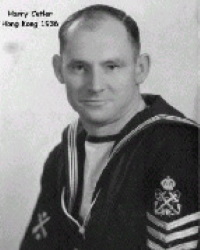
Place of birth: Southampton, Hampshire, England
Service: Royal Navy
Rank: Ordinary Seaman
Service Number: J101329
Joined Hood: 9th June 1922 (Boy 1st Class)
Left Hood: 5th January 1925 (Able Seaman)
Biographical Information:
I joined the Navy on 15 Feb 1921 at Southampton and was passed educationally and physically. On the same day, I was sent to H.M.S. IMPREGNABLE at Plymouth, where I was given accommodation and food as it was 8pm when I arrived.
H.M.S. IMPREGNABLE, my training establishment consisted of the old pre First World War warships H.M.S. POWERFUL, H.M.S. ANDROMEDA, and H.M.S. BLACK PRINCE which had been converted to living quarters, physical education, seamanship and general education rooms.
Captain Gordon Campbell VC was the Captain of H.M.S. IMPREGNABLE. He was of interest because of his exploits of during the First World War. He had been awarded the VC for his fight against the German U-boats.
There was also H.M.S. CAROLINA, which had been converted to contain a swimming pool for Boys who could not swim, of which I was one - but soon learned to! Navy life was an experience, and one that was rough at first, but by the end was able to enjoy the training. There were a few Boys who did not get through. Very few were bought out. A few were classified as physically unfit or medically unfit and several could not, or did not want, to pass. All sorts of tricks where tried.
The establishment was moored in the harbour off Torpoint, on the Cornwall side of the harbour and near the playing field and rifle range where we practised rifle firing.
H.M.S. POWERFUL was where the gunnery training took place and the 6" and 4" guns were still in place. All the ammunition we used at that time was imitations of real size. The Captains and the Officers quarters were on the POWERFUL.
The day after I joined and during the following 3 days we were put into classes, kitted-out and shown around. I had to get used to sleeping in a hammock, naval ways and the parts of the ship. Then followed five days a week of instruction in seamanship, gunnery, and how to clean ship. There was also physical instruction for a half-hour each day in addition to each class on hour twice a week. On Wednesday afternoons, Saturday and Sundays we went to Trevol playing field for sports. This was also part of our instruction as had to row ashore in cutters and pinnaces.
At the Sports field we had to take part in many sports. As time went one was sorted into what one was best at ...Cricket was mine. When at Trevol sports field the First Class Boys were allowed to walk to Anthony, a village 3 miles from Torpoint, Cornwall, where the playing fields were situated. After eight months training Boys were made to First Class, which meant an increase in pay as well as being allowed to visit Anthony.
On Sundays, religious services were held on board for all of the Church of England faith. Non-conformists, when weather was fit rowed ashore. As I was a Methodist, I sometimes went to the Welcome Hall in Fore Street, Devonport which was a Methodist hall but most Sundays service was held at the Kerr Street Methodist Chapel. At all times Boys were supervised. After I had been made a First Class Boy I joined a party of Methodist Faith which was picked and allowed to go to the Welcome for indoor games and tea, although we were still supervised. I was a naughty Boy one Saturday as, with my friend, a local Boy, I got out and went to a Plymouth Argyle Football match. We walked and ran there and had just enough money to get into the ground. We got back OK in time as my friend knew the way.
As Boys at that time, we were allowed only one old shilling in our pockets, which was paid each week. The remainder of pay was kept for you. I was able to purchase from the Purser any item of clothing required outside the issue. After a year and two months training (approx.) I was kitted up for sea with a full kit and from that day onwards had a clothing allowance and had to purchase any replacement required.
My training was completed late March 1922 and I ready to go to sea having been passed professionally and educationally to be retained in Navy.
That ends the brief account of the training and ready for sea. To give a full account of all incidents of the time aboard and the actual training would take a book.
H.M.S. Hood (Battle Cruiser)
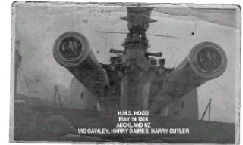 On 8th June 1922, I joined H.M.S. HOOD - a very large Battle Cruiser. Luckily, she was with the Home Fleet which was quite large. My first trip was with the Fleet on exercises and drills. During harbour time we visited several places but I could not go ashore as I was still a Boy. I had 14 days leave end of July. Going to sea was an experience I shall always remember.
On 8th June 1922, I joined H.M.S. HOOD - a very large Battle Cruiser. Luckily, she was with the Home Fleet which was quite large. My first trip was with the Fleet on exercises and drills. During harbour time we visited several places but I could not go ashore as I was still a Boy. I had 14 days leave end of July. Going to sea was an experience I shall always remember.
After my leave it was back to sea as usual. After a few weeks in HOOD, we went to Rosyth Scotland to dry dock for minor repairs and cleaning the ships bottom. Rosyth was the only dry dock in the country large enough to take the Hood. While there I was able to go to the playing fields for sport of an afternoon, but as usual was supervised.
After our docking we went back to sea. Most of the Fleet was at Scapa Flow, others at Invergordon. Scapa Flow was in the Orkney Isles and Invergordon near Solway Firth. The ship was recalled to Devonport to give leave and make ready, and I was chosen to represent the British Navy at the Brazilian Century Celebrations at Rio de Janeiro. On the way down to Brazil, we called at Sierra Leone. After the celebrations we went down to Santos where I went ashore as the Boys had invitations from the British Community join them for tea and I was one of the lucky ones.
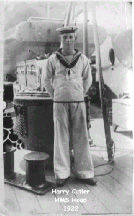
On the way back to England we visited Trinidad and Jamaica. I was lucky there too as I had a game of Cricket with a Boys team. We arrived back at Devonport early December. I had Christmas at home as I had done on my training ships.
As usual, it was back at sea in mid January, but the Fleet went to Gibraltar for exercise with the Mediterranean Fleet. After exercises the Fleet dispersed to various places with, as usual, no leave. We got back to Devonport mid April and had Easter leave. There was a summer cruise and I was made Ordinary Seaman 14 May 1923.
We visited Christiana Norway (Oslo now) and at last I could go ashore unsupervised, but had to be back on board by the 10pm boat 2200. I went on a sightseeing tour whilst ashore and, unfortunately. On my second time ashore missed the 10pm boat and was punished accordingly. No excuse was taken but I had taken a wrong turning on my way back to the boat.
At the end of the cruise it was back to Invergordon and then Devonport. After leave, it was back to sea for exercises off Bournemouth. I was on duty that night could not go ashore. We went back to Devonport early after those exercises as HOOD had been selected as Flagship of a "Special Service Squadron" to tour the world.
The Squadron consisted of the following ships:
Battle Cruisers
H.M.S. HOOD
H.M.S. REPULSE
Cruisers
H.M.S. DELHI
H.M.S. DANEA
H.M.S. DAUNTLESS
H.M.S. DRAGON
H.M.S. DUNEDIN
My memories of the "Empire Cruise"
HOOD left Devonport mid November. The first place visited was Sierra Leone. Whilst there I had a train ride out in the jungle to a place called Sutton. I also had a couple of days looking around Sierra Leone. It was an experience!
Left for Cape Town mid December arrived just before Christmas. Made friends whilst ashore, and when ashore met them and saw more of Cape Town with them than otherwise would have on ones own. Had Christmas on board on duty.
Left Cape Town 2 Jan 1924 for Zanzibar, crossed to Colombo Ceylon. Usual run ashore when we could. One wanted to see as much as possible. From Colombo we went to the Naval Base at Trincomalee and whilst there had Harbour Drills. There was a dockyard there, which could do minor upper repairs and supply stores to ships of the Far East Fleet. Some of the ships were based at Hong Kong and at Trincomalee for the Indian Ocean.
From Trincomalee across to Port Swettenham Malaysia. I did go ashore once there and went up to Kuala Lumpur which was the capital of Malaysia. Quite a place!
From Port Swettenham to Singapore which has a huge oil terminal and a Naval Dockyard with a Naval Hospital. I went ashore once and was made Able Seaman whilst there.
From Singapore to Freemantle Australia. I was made quite welcome once ashore and as I was then an Able Seaman could have stayed ashore but did not.
From Freemantle to Perth and as usual quite a nice time. I met a couple and my friend and I where shown around the town. We saw a film and stayed ashore one night. Most cinemas were free.
Perth to Adelaide. The stay was an enjoyable one as it was a lovely city. I was ashore three times as we met friends and were shown around. As the ship was open to visitors I was able to show friends around.
Adelaide to Melbourne. Went alongside a jetty there and was ashore a couple of times. Whilst we were there my mate met a gentleman at the gangway who could not get aboard. Whilst they were talking the gentleman asked if anyone on board was from Dorset, and my mate told him that I was and from the Gaunts Common. It turned out he was from the next village. Later, at about 7pm, my mate told me of this and gave me an address to call. It turned out that the gentleman had known my father when they had both been young men. His name was Mr. Shears of Chalbury and he had emigrated to Australia in 1894. Unfortunately, he and his daughter where going back to a place called "Dalesford" 100 miles north of Melbourne. I was able to go and see them off the next day at Flinders St. Railway Station. It was a chance in millions to meet like that. Melbourne was a very large city but we had a lovely time.
Melbourne to Hobart, Tasmania. I was once ashore to have a look around, the people there were very friendly.
Hobart to Sydney. Another large city. I saw quite a lot of it as I was driven around by a gentleman who offered us a lift - which was great. I also had a day at the Races as an invitation was given to the ship and free of an entrance fee. I went for the experience as I had never been to a race meeting before and came away slightly better off than when I went in. HAVE NOT BEEN TO A Race meeting since as I was not keen on it. An unusual place to remember.
Sydney to Wellington NZ. Quite an enjoyable stay. Met some locals and I was invited to a ride around and back to their place for a meal of which was enjoyable. Next time ashore went to a cinema.
Wellington to Auckland. There I had a most enjoyable time as Mr. Shears in Melbourne had sent a message to a relation of his who was there and told him about me. I was given an address to contact him, which I did the first day we were there. When I did I was told to bring two pals which I did and each day when we could get away. We were taken around by car - even down to the famous Hot Spring off the North of North Island of New Zealand - about 40 miles from Auckland. I kept in touch for years after with the Shears and Mr. Gus Paul of Auckland - which was the most enjoyable of all. Once since I have seen a film of Auckland taken by a Lady who visited a relative there. It was at an old Peoples Club in Dorset when I was visiting my sister in Wimbourne, Dorset. It brought back memories as recognized several places.
Auckland to Fiji. I was only once ashore and was made welcome by the natives who had never seen a sight like the HOOD. Not much to see other than it being a tropical island.
Fiji to Honolulu. That's a place to remember especially the surf! I was on the beach once to see the surf and try it and was under supervision by the beach guards most of the time. My time ashore was spent sight seeing and was enjoyed it in spite of the heat. I also enjoyed meeting and conversing with the people.
Honolulu to Victoria Canada. Quite a nice place. I was only once ashore but enjoyed it.
Victoria to Vancouver. Quite a large city. I went sight seeing as usual when ashore and was made welcome by the people. One day was wet so I went to a cinema. The contrast of cinemas then and now, both enjoyable in their way.
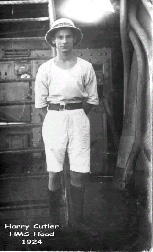 Vancouver to San Francisco. It was a short stay there but a very enjoyable one as my friend was on duty and he was showing visitors around the ship. He was invited with a friend to visit them at their place which was out of town. He was given instructions on how to get there by streetcar at a place which was near the landing place. It was three quarters of an hour ride to a certain place then the car changed into a Rail Car instead of overhead cable to ground rail. It was really a grand trip. The place was Burlingcome. After supper, their evening meal, we came back to the city auditorium as the Hosts were on the committee organizing a dance for the HOOD. It was a grand day! That was the last day of our stay there as we were sailing next day and all had to be back by the midnight boat.
Vancouver to San Francisco. It was a short stay there but a very enjoyable one as my friend was on duty and he was showing visitors around the ship. He was invited with a friend to visit them at their place which was out of town. He was given instructions on how to get there by streetcar at a place which was near the landing place. It was three quarters of an hour ride to a certain place then the car changed into a Rail Car instead of overhead cable to ground rail. It was really a grand trip. The place was Burlingcome. After supper, their evening meal, we came back to the city auditorium as the Hosts were on the committee organizing a dance for the HOOD. It was a grand day! That was the last day of our stay there as we were sailing next day and all had to be back by the midnight boat.
San Francisco to Jamaica. This included a trip from the Pacific through the Panama Canal to the Atlantic. The lock on the pacific side lifted the ship up to the inland lakes and locks which led down to the Caribbean sea and Atlantic Ocean. A wonderful feat of engineering.
Jamaica to Halifax. We had quite a nice time there and the hospitality was great. I played a game of cricket there and went to the cinema, which was free - as was the accommodation too. I was able to stay till 7am. The harbour was a very large one and a very busy shipping port. As usual enjoyed the stay!
Halifax to Quebec City. It was a place of real interest as was historical and I was able to see most, which I enjoyed doing. Did not stay ashore of a night. Most of the talk was French.
That was our last town or city to visit on tour as we went to Topsail Bay in Newfoundland thereafter. Whilst there we had drills - which we had been unable to do in harbour in most places we visited. Visitors were allowed on board and shown around by a member of the crew, as I did on several occasions. We left Topsail Bay on 21 Sep 1924 arriving in Devonport 29th after a wonderful cruise. It was a cruise to show the Flag to, as it was then, The British Empire. A cruise to remember!
H.M.S. Glorious (Light Battle Cruiser)
 Dates aboard: 01-10 May 1925
Dates aboard: 01-10 May 1925
Statistics:
18,000 tons
Speed 31 Knots +
4 15" Guns Twin Turrets one Forward one Aft.
4 4" High Angle Anti Aircraft Guns
4 2" Pounder Guns
4 Pom Poms
Rifles for Marines and ceremonial occasions.
H.M.S. GLORIOUS was built for speed. She did see a little service in First World War and had two sister ships - H.M.S. COURAGEOUS and FURIOUS. They were all converted to Aircraft Carriers between the First and Second World Wars.
I left H.M.S. Impregnable on 17April 1922 for H.M.S. GLORIOUS which was then waiting to go to sea. Whilst there I had duties as Messenger Boy. I was able to have several games of Cricket as there were several teams of Boys and ships crew which was a Reserve crew. As usual, I was still supervised being a Boy under 18.
H.M.S. Douglas D70 (Destroyer)
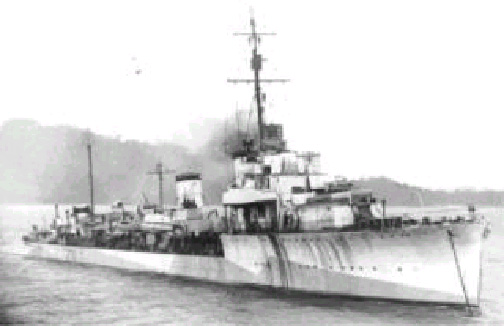 Dates aboard: 10 June 1925 to 6 November 1925
Dates aboard: 10 June 1925 to 6 November 1925
Statistics:
1700 Tons
Speed 31 Knots
4.7 Guns Two Forward Two Aft.
Pom Pom’s Midships
Lewis Guns on Bridge
Rifles for Ceremonial occasions if needed.
Built in 1915 was one of the Montrose Class of Destroyer.
Routine at sea and in Harbour: The ship was in reserve and so had very few aboard. Our duty was to keep the ship clean and in serviceable condition. We went to sea once during which we had extra crew aboard for trials. This was only for a few days. The ship was broken up after new Destroyers where built in the late 1920’s. The date of being broken up is not known. There were much later built Destroyers that were in reserve and able to be mobilized. Most were altered after eventual mobilization to the needs of War - especially long range.
Note from website staff- We are uncertain if Harry actually meant H.M.S. Douglas or another ship. This is because H.M.S. Douglas was actually a destroyer of the Admiralty Leader class and had a pennant number of D90. She remained in service throughout World War 2 and was broken up shortly after the war.
H.M.S. Volunteer D71 (Destroyer)
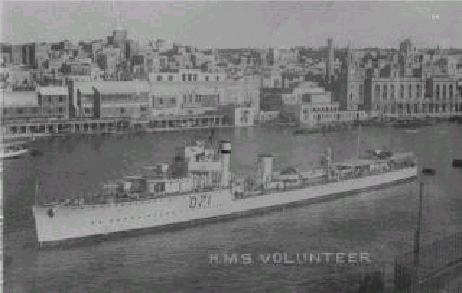 Dates aboard: 29 April 1926 to 30 June 1928
Dates aboard: 29 April 1926 to 30 June 1928
Statistics:
Built 1916
1575 Tons
Speed 31 Knots
4.7" Guns Two Forward Two Aft.
Pom Pom’s Midships
2 Lewis Guns on Bridge
Torpedo Tubes Midships in two sets of three tubes. We had Torpedoes in the tubes but they were not armed with war heads - only practice heads. When used for practice torpedoes were recovered to be used again.
Service in the Mediterranean Fleet. At this time the ship was not a submarine detecting Destroyer, but at a later date, 1930’s she was converted as were most of the old class of Destroyers. Some were considered unsuitable as they were too old. All destroyers from 1928 were built with the detection gear. At that time it was in its infancy, (1928) even though it had been in for several years experimentally. As the years went on it was improved. By the end of the War it was improved considerably. When first used there was the difficulty of distinguishing between the echo sound of a steel object or other objects in the sea. When the War started it was not quite over-come but very useful in submarine detection. Operators of the submarine detection gear were trained at a school at Portland, Dorset. This was both theory and practical as my next ship will show.
Routine at sea and in Harbour: We served with the Mediterranean Fleet in the 4th Destroyer Squadron of nine ships in a Flotilla., two (as called) Divisions of 4 ships with one Destroyer with a Captain aboard in charge of the Flotilla. Each Division of 4 ships had one ship with a Commander as Captain of the ship. Each of the others had a Lt. Commander as Captain. At that time there were four Flotillas serving in Malta. After a Flotilla had served 2 years 4 months or so, it was sent back to England to pay off and all crew left the ship which was replaced by a new one which was sent aboard after a refit in the home ports. Therefore, at those times only 3 Flotillas were on station.
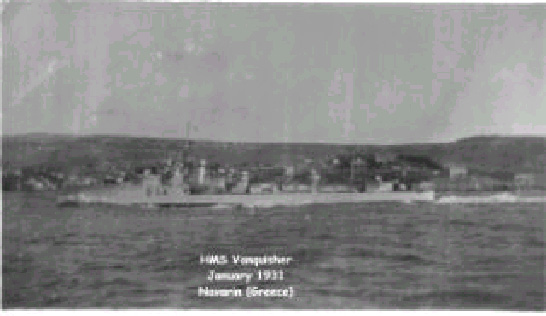 My first experience of life in a Destroyer was when we left Devonport on 6 May 1926 for Gibraltar and Malta. As usual all ships fuelled and took fresh stores. Unfortunately, "VOLUNTEER" was detailed for the Tangier Patrol. We did 3 days out and were relieved by another ship. We were on the lookout for gun running but did not have any trouble. We had to go back to Malta as one of the turbines was causing trouble. As the ship had to go in Dockyard to be repaired most of the ship’s company was distributed around the Flotilla. I went to the WYVERN, which was same class as VOLUNTEER. We did have a period at sea as it was the Fleet manoeuvres at the time. On return to Malta I rejoined my ship she had been repaired by then. As usual we had trials to do which at this time were to test the ship for her ability to rejoin the Flotilla which was passed OK.
My first experience of life in a Destroyer was when we left Devonport on 6 May 1926 for Gibraltar and Malta. As usual all ships fuelled and took fresh stores. Unfortunately, "VOLUNTEER" was detailed for the Tangier Patrol. We did 3 days out and were relieved by another ship. We were on the lookout for gun running but did not have any trouble. We had to go back to Malta as one of the turbines was causing trouble. As the ship had to go in Dockyard to be repaired most of the ship’s company was distributed around the Flotilla. I went to the WYVERN, which was same class as VOLUNTEER. We did have a period at sea as it was the Fleet manoeuvres at the time. On return to Malta I rejoined my ship she had been repaired by then. As usual we had trials to do which at this time were to test the ship for her ability to rejoin the Flotilla which was passed OK.
Now the routine of ship in harbour and at sea, as from September 1926 the Fleet put to sea for exercises. As we had no submarine detection aboard, could only be used for patrol and practice high-speed attacks by torpedoes on big ships.
At sea the crew was split into watches, Port and Starboard. Each watch was split into two. When going from place to place each part of watch was on duty for 4 hours. Watches called Forenoon 8-12 (0800-1200) 12-4 PM (1200-1600) 1st Dog Watch 4-6pm (1600-1800) 2nd Dog Watch 6-8pm (1800-2000) First Watch from 8pm-Midnight (2000-2400). Each watch or part, had to supply lookouts on the bridge in 8 not more than one hour at a time. A seaboats crew of 5, one Leading seaman for Coxswain, 4 Ratings for lowering seaboat which at time was exercised to pick up a man overboard which was represented by a life buoy thrown overboard. It could not have been done in gales or very rough seas.
Exercises with the Fleet were War Manoeuvres in which, instead of part of the watch, the whole watch was on duty with extra lookouts and certain guns manned. After several days action stations was called, everyone went on their action station as allotted. That was when the two parts of the Fleet met in mock battle. (Red and Blue). After all exercises had been completed the Fleet dispersed. Most ships went to various places to anchor and give leave. We had 2 Aircraft Carriers with Fleet and these also took part in the manoeuvres.
Destroyers usually went to Navarin Bay in one of the Greek islands. This was a place for harbour exercises or rather drills such as "prepare to tow forward" and also "aft", "away all boats," or "abandon ship." In "away all boats," we included Carley Floats in the exercise. It was essential some crew stayed on board to keep the ship running.
Another drill was getting the anchors up by manual work as each ship carried capstan bars and as many men as could get on were used. A smaller (kedge) anchor was taken in a boat, a whaler, to represent when a ship was aground the anchor was dropped from the boat with wire attached and the ship then tried manually to pull ship off. It was a drill, which in theory was workable.
Once whilst on "VOLUNTEER" we had to actually carry out the towing of another Destroyer and being towed This exercise was successful. It was quite a job getting prepared before the actual towing. Destroyers were quite powerful ships and able to tow each other at a nice speed in good weather. In bad weather, getting the towing wire from the ship being towed to the towing ship was tricky. This was done with a Coston Gun firing a line from ship to ship and then hauling aboard a heaving line with a grass rope 2" (which floated when in the water). The wire from the ship being towed was hauled aboard and secured to a towing bollard. When that was done the ship being towed paid out the wire, which was attached to a cables length of anchor cable. The wire rope used in Destroyers was 3". The worst part of this and the hardest was replacing everything afterwards. The Mediterranean Fleet had three periods of exercises - Spring, from January to early April; Summer, from Mid May to Mid August and Autumn from Mid September to early November.
The Spring period was in the west Mediterranean and Gibraltar where we met the Home Fleet on War exercises. One spring it was in the Atlantic next in the Mediterranean. The exercises used to last two, possibly three weeks. After completion of exercises the Mediterranean Fleet went to various places. It was the same with the summer cruise also the autumn one.
The VOLUNTEER's first exercise was autumn 1926 as she was not ready before. Afterwards we visited places then back to Malta. We did not get any long leave - only nights ashore - when on duty, which was every 4th day. Duties were carried out by what was called Duty Watch. Malta was quite nice.
There was plenty of sports: Cricket, Football, Rugby, Tennis, Athletics. I had a friend from another ship and we both enjoyed a game of billiards.
Whilst at Malta the Fleet put to sea for gunnery practice and a real firing at a target towed by another ship. They had a director aboard to fire guns. When they wanted to fire a salvo, all four guns were fired together by the Director Layer, if ordered. Independent firing of the guns could also be carried out if required by Gunlayer of each Gun. Both firings were carried out on the sound of a bell. Destroyers built from 1927 also had more modern Directors to improve the efficiency of firing the guns and guns of a uniform size - 4.7". Gunnery improved on as time went on - more range.
H.M.S. P 40 (Submarine Detection Ship)
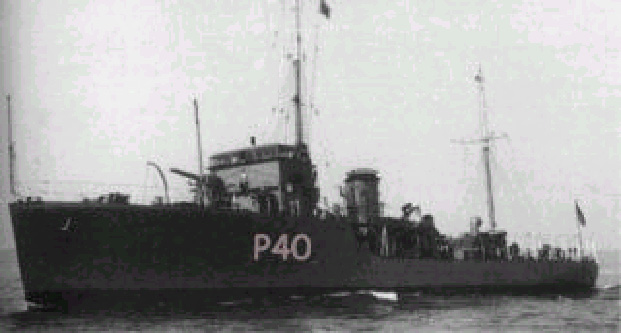 Dates aboard: 15-1-29 to 10-10-29
Dates aboard: 15-1-29 to 10-10-29
Statistics:
Speed 26 Knots (if required)
She had been converted from a patrol boat of 750 Tons with a single 4" gun with a set of 3 torpedo tubes and depth charges.
She had been built in 1914 and used for patrolling coast for submarines and German E-Boats. During conversion, in early 1920’s, the torpedo tubes were removed as was other parts. She was fitted with an underwater dome to the bottom of the ship which contained the echo sounding gear. The ship was attached to the training school called H.M.S. OSPREY .
Several days a week parties of ratings from H.M.S. OSPREY came aboard for training at sea with a submarine. We put to sea for about 6-7 hours a day for 3 days a week and 4 days at various times of the year. Weekend leave periods were not used for training. Once a year we went to sea for 2-3 weeks for training with the Home Fleet. At that time we had an increase of crew for watch keeping as when training at Portland we had just enough to man the ship. There was very little change of routine as it was just training. One cruise, when we were on annual exercise of three weeks, we went to the Channel Islands after exercises.
H.M.S. Vanquisher D54 (Destroyer)
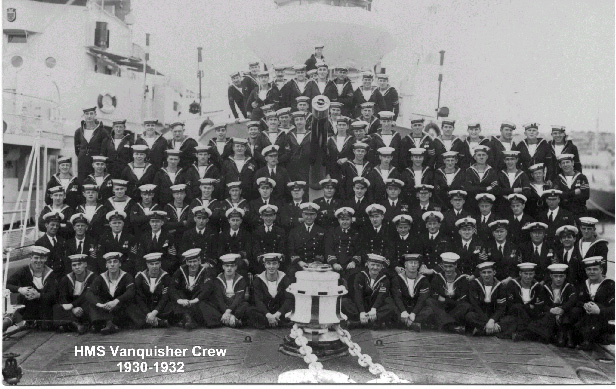 Dates aboard: 11 November 1929 to 29 April 1932
Dates aboard: 11 November 1929 to 29 April 1932
Statistics:
1500 Tons
Speed 30 Knots
Built 1915
4" Guns and same armament as H.M.S. VOLUNTEER outside 4.7" Guns
VANQUISHER was fitted with the submarine detection gear. This unit was used when we were at sea with the Fleet for training purposes and war games.
We were in the 2nd Destroyer Flotilla. There were nine Destroyers in the Flotilla all of which were fitted with the detection gear. One other Flotilla was similarly fitted as new Destroyers built 1929 onwards were replacing the old ones, which were being scrapped. The new Destroyers could stay at sea for 10 days as were fitted with refrigerated food and more stores as well as being more economical in fuel consumption.
Places Visited: Mediterranean. Athens, Rhodes, Phalorah Bay, Navarin, Sciathos, Greece. We went through the Corinth Canal. Limasol and Pharmagsta, Cyprus twice, Split, Dubrovnic, Lucinpiccalo Yugoslavia as it then was, Venice Rapald, Genoa, Naples Italy, Toulon, Ville, France, Nice, Monte Carlo. There were a few other places visited - most of them very small and we stayed only a few days. Port Said, Alexandria Egypt, Algiers (Morocco). Those two commissions in the Mediterranean Fleet were enjoyable though the absence from home not too nice, but the places visited and sports passed the time quite well.
H.M.S. Valentine D49 (Destroyer)
 Dates aboard: 18 April 1933 to 10 June 1934
Dates aboard: 18 April 1933 to 10 June 1934
We were in the Home Fleet. The ship was similar to my previous destroyers except that she was built with an extra cabin under the Bridge.
The ship was built as half leader of a Destroyer Flotilla with an extra officer aboard. At this time oiling at sea was being practiced by Destroyers - taking oil from the Battleships of the Fleet. It was very interesting as different methods were used.
Places Visited in "VALENTINE": Copenhagen (Denmark), Vastavic, Sweden Keil Canal Harwich, Newport Cardiff, Tipperary Bay (Ireland).
Was there Christmas 1933 as was on Gun running Patrol for 3 weeks. We spent several weeks at Roysth, and I was able then to visit Dunfermline and Edinburgh as both were quite near and I had leave. Most Destroyers fitted with submarine detecting gear had time at Portland which was relaxing as one could go over to Weymouth of an evening.
I was made Leading Seaman whilst aboard and, as usual, had to leave ship when one is promoted. I went into Royal Naval Barracks and to the Gunnery School for a five months gunnery course for a Director Layer First Class.
H.M.S. Dorsetshire (Cruiser)
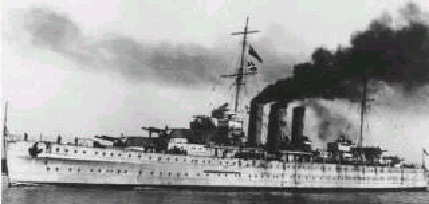 Dates aboard: 23-5-35 to 27-6-37
Dates aboard: 23-5-35 to 27-6-37
Statistics:
10,000 Tons
8" Guns Twin Turrets (2 forward, 2 aft)
4" Anti Aircraft High Angle Guns
Pom Poms Midships
2 Pounder Guns also used as Saluting Guns.
Torpedo Tubes under water Two Port Two Starboard Forward.
Carried a Swordfish Plane with floats and 18" torpedo on the catapult amidships. This was also used as a reconnaissance plane during exercises once a year or so. It used a dummy torpedo for practice attacks on targets. It was a Swordfish Aircraft from an Aircraft Carrier, which disabled the BISMARCK by a torpedo enabling the Fleet to destroy it.
Also on board was a field gun and carriage used for ceremonial occasions. This was also used with gun removed for funerals of Naval Ratings - of which we had one aboard in 1936.
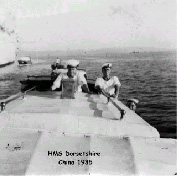
I was made Petty Officer whilst on board but did not leave ship as usually one does as two Petty Officers were required. So I did not leave "DORSETSHIRE" until we returned to England 29 Jun 1937.
Places visited: On trip to the China station called into Malta then went through Suez Canal. Ishmalia, Aden, Colombo, Singapore to Hong Kong - The China Fleet base. Visited Japan, Yokohama, Beppu, Kagoshima, Myajima. Whilst at Yokohama I was lucky as I had three days' leave and was under the care of a Salvation Army guide. We were a party of 20 in our group. We stayed the night in Salvation Army accommodation and next morning I took a train to Tokyo. That day we had a sight seeing tour with guide, also next day returned to Yokohama and back aboard at 10 p.m. Three very enjoyable days. That was the only visit we had to Japan.
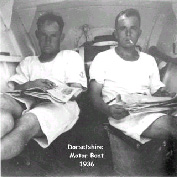 We also visited Hankow 600 miles up the Yangzee River. That took 3 days. We were actually a Guard ship but had quite a nice time with Cricket and sight seeing. We went to Shanghai 3 times, as it was an International city at that time. Could visit the Americans, French but Japanese we were not advised to visit. We had good accommodation in the English sector and nice cinemas, which when ashore able to stay after a late show also quite cheap. Tsingtau - a town which was annexed from the Germans after 1st World War 1914-18. Sandikam Java Borneo East India Isles also a few others as I said Hong Kong was the Base of the Fleet.
We also visited Hankow 600 miles up the Yangzee River. That took 3 days. We were actually a Guard ship but had quite a nice time with Cricket and sight seeing. We went to Shanghai 3 times, as it was an International city at that time. Could visit the Americans, French but Japanese we were not advised to visit. We had good accommodation in the English sector and nice cinemas, which when ashore able to stay after a late show also quite cheap. Tsingtau - a town which was annexed from the Germans after 1st World War 1914-18. Sandikam Java Borneo East India Isles also a few others as I said Hong Kong was the Base of the Fleet.
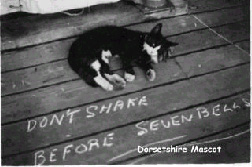 We spent winter there with summer up North Whi Hia Whi (pronounced 'way hi way'). Summer was quite warm, but winter very cold. The harbour often froze over but not enough to be Ice bound. A ship was left on duty there after the Fleet left to winter in the South. We did not get a duty up there (was lucky). I did hear of one ship getting frozen in for a while in a very severe spell just after the 1st World War. Hong Kong was the Dockyard with facilities for repairs and annual docking of ships. Kowloon on the mainland was the sports ground and one could go out of town sight seeing. To get over there was the Star Ferry Sam Pam, and at times the ships motor boat would go across at certain times. Whilst there had a weeks camp in the hills on the border of the English Province and part of China, which was under Japanese jurisdiction. In a ship of DORSETSHIRE size there was always a platoon of sailors from the gunnery branch selected for anything like that. The Platoon of which I was in was selected. It was an Army outpost. Our Platoon had field drill but mostly observed the Army at drills. It was two extremes as during the day Tropical Rig, at nights Serge as temperature dropped to just below freezing, so felt cold. By 9am was back in Tropical Rig. An experience, but not one which I would want too often! That commission was under two years as at that time they were beginning to get shorter before that it was normally two to two and a half years. That was my last commission abroad as was at home 1937-1939 then the War.
We spent winter there with summer up North Whi Hia Whi (pronounced 'way hi way'). Summer was quite warm, but winter very cold. The harbour often froze over but not enough to be Ice bound. A ship was left on duty there after the Fleet left to winter in the South. We did not get a duty up there (was lucky). I did hear of one ship getting frozen in for a while in a very severe spell just after the 1st World War. Hong Kong was the Dockyard with facilities for repairs and annual docking of ships. Kowloon on the mainland was the sports ground and one could go out of town sight seeing. To get over there was the Star Ferry Sam Pam, and at times the ships motor boat would go across at certain times. Whilst there had a weeks camp in the hills on the border of the English Province and part of China, which was under Japanese jurisdiction. In a ship of DORSETSHIRE size there was always a platoon of sailors from the gunnery branch selected for anything like that. The Platoon of which I was in was selected. It was an Army outpost. Our Platoon had field drill but mostly observed the Army at drills. It was two extremes as during the day Tropical Rig, at nights Serge as temperature dropped to just below freezing, so felt cold. By 9am was back in Tropical Rig. An experience, but not one which I would want too often! That commission was under two years as at that time they were beginning to get shorter before that it was normally two to two and a half years. That was my last commission abroad as was at home 1937-1939 then the War.
H.M.S. Fearless H67 (Destroyer)
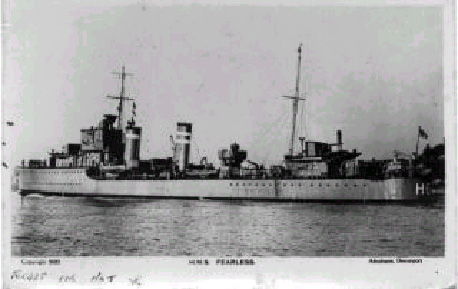 Dates aboard: 27 June 1937 to 28 June 1939
Dates aboard: 27 June 1937 to 28 June 1939
Statistics:
1750 Tons
Built 1934
1x 4.7" Guns Two forward two Aft.
1x Pom Pom
1xSets of 4 Torpedo Tubes Amidships.
2xDepth Charge throwers 1 Port 1 Starboard
Depth Charge rails aft for dropping aft.
Rifles as usual on a Destroyer for ceremonial purposes and rifle shooting on a range.
Again we had submarine detection equipment aboard.
On this ship was what was called a "two speed Destroyer Sweep." Paravanes were towed astern of ship on wires. The Paravanes were set at certain depths, one each side of the wires. Towing them would guide them to the Mines. Paravanes that would then cut the wires and mines would drift to the surface then be destroyed. Usually mine fields were set for deep draught ships such as Battleships. This equipment was not fitted on any of the other Destroyers I ever heard of. When I went aboard was given the job Petty Officer in charge of the TSD’s. The Officer in Charge gave me one practice sweep watching, which was plenty as with the book reading and the watching I was quite confident. In the next 2 years things were quite easy. After 4 months aboard the Chief Bosuns Mate left the ship and as I was the next senior Petty Officer I had to take over. I was in charge of the upper deck and seamen, also of the issue of ropes and cleaning materials. The ship was with the Home Fleet.
Places Visited: The first duty was on North Spanish coast Patrol during the Spanish Civil War. We were stationed at St. Jean De Luz in the Bay of Biscay (near to Spain) - at the very South West corner of France. Here. it was 8 days at sea and 4 in. We were there till mid December when we came home for leave. We were relieved by another Destroyer. "FEARLESS" was a long-range ship, so she was able to stay at sea much longer.
I was able to go ashore whilst away and met a person and made friends - all because I was able to get permission to show the friend aboard. I went ashore for a lunch when next in harbour. For the next 3 times in harbour after that I had one evening meal 2 lunches. It was 2 sisters, one a lady convalescing. The last time ashore I was taken on a car ride by the sick ladys husband. We went up in the mountains - the Pyrenees - for 20 miles, then across that corner of France to Bordeaux and back to St. Jean. I was told it was about 130 miles a trip which I thoroughly enjoyed. That was the last time I saw them as they were returning to Paris. I rejoined Fleet in January 1938, as usual after exercises. Visited Lagos, Oporto, Lisbon, Portugal, Helenssburgh, Glasgow, The last named was for the ship to represent the Navy at the Glasgow Empire Exhibition of 1938. We also went to Stavanger (Norway), and Hull.
H.M.S. Whitehall H94 (Destroyer)
 Dates aboard: 31 Jun 1939 to 1 May 1942
Dates aboard: 31 Jun 1939 to 1 May 1942
Statistics:
Built in 1916 of the V and W class
1545 Tons
Speed 31 knots
Armament same as the H.M.S. Volunteer
I left FEARLESS on 28 June 1939 for Barracks. The Reserve Fleet was mobilized at various ports on 30 Jun 1939. This meant crews were sent from Barracks to various ships. I was sent to Chatham, where "Whitehall" was and commissioned the ship on 31Jun 1939. After an over night journey from Plymouth we were rather tired. After a period at sea with the Reserve Fleet training, we went to Weymouth were all the Reserve Fleet assembled. The King then reviewed the Fleet. After review we were dispatched to various places around the country.
"WHITEHALL" was dispatched to Rosyth Scotland. From there we spent time at sea training in submarine detection as the ship had been fitted before it went in reserve. We also did patrols near the coast from Hull to Rosyth. That continued till November 1939 when we went back to Devonport as our base. From there we picked up a convoy out in the English Channel and was with them for 3 days out to pick up a convoy coming from Canada or the South Atlantic. "WHITEHALL" could only do six days at sea without oiling, as oiling at sea then wasn’t done.
We continued on that duty till the Dunkirk evacuation in which we took part. After Dunkirk, we had to go to the dockyard as, several weeks before Dunkirk, one of the 3 boilers had broken down so we could only do 22 Knots. We had a new one put in which took 6 weeks. After trials, we were on patrol off the French coast, no incidents.
On 28 Sep 1940 we were sent to Liverpool where we were on convoy duties in North Atlantic. During convoy duties we had several attacks on submarines with Depth Charges. Only once did we have a possible sinking, as wreckage came to the surface. We continued on convoy duties till 1 Jan 1942 when we went to Gibraltar on escort duties for Force H. This included convoy duties to Aircraft Carriers flying Fighter Aircraft to Malta.
20 March 1942 we escorted a Liner from Gibraltar to Plymouth until other ships took over and she was covered by land Aircraft. On that occasion we were very lucky to get back as it was very calm sea all the way. Also the visibility was very hazy all the way home. No aircraft was able to search in that visibility - very lucky as it was near to German occupied France. On arrival left WHITEHALL, where I had been for 2 years 11 months.
I returned to the Royal Naval Barracks until I was drafted to Wembury where the Anti Aircraft Gunnery School (training) was. I manned the Guns during Air Raids and was there till 20 Mar 1943.
H.M.S. Hesperous H57 (Destroyer)
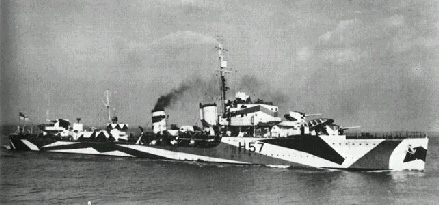 Dates aboard: 22 March 1943 to 3 Sep 1943
Dates aboard: 22 March 1943 to 3 Sep 1943
Statistics:
Built 1937
1750 Tons
Speed 31 + Knots
4x4.7" Guns - same Armament as "Fearless", but during the War she was altered to carry more Depth Charges.
2 Guns were taken out and she was built as a long range destroyer whilst I was on the ship. We were at Liverpool and on long range convoy duties crossing the Atlantic to Newfoundland.
We had to take one convoy out, and one back. By that time oiling at sea was routine and an Oiler was in the convoy.
The ESCORT used to oil once a day weather and submarines allowing! We had several encounters with Subs and with good results, but no damage to our ship, crew or convoy. We did not lose a ship of convoy whilst I aboard. By this period of the War the Submarine threat was lessening.
I took over as Chief Bosuns Mate of the ship as was senior to all the other Petty Officers aboard. That was always the routine in any ship. After six months aboard it was found that I was not required aboard as I was the wrong Gunnery Rating as she had no Director aboard, and I was a Director Layer 1st Class so I was posted back to Barracks and Gunnery School.
H.M.S. Renown (Battle Cruiser)
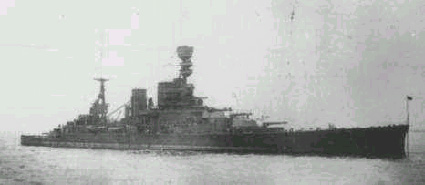 Dates aboard: 26 October 1943 to 15 April 1944
Dates aboard: 26 October 1943 to 15 April 1944
Statistics:
29,000 Tons
6x15" Guns 3 twin turrets 2 forward 1 Aft.
12x4" Guns 1 forward 1 Aft 4 Port 4 Starboard
6x Pom Poms
4x4" Anti-aircraft Guns
4x 2 Pounders used for Saluting as well.
4x Lewis Guns on Bridge
Rifles for Marines use and ceremonial purposes.
I joined the ship in Rosyth and went out to the Far East. We were based at Trincomalee, Ceylon Naval Base. We had patrols in the Indian Ocean but were not required to go to the Pacific as we were not needed. The Americans had the Japanese on the run and the Japanese Fleet was of no real threat as they had no Aircraft Carriers of note. Had one of our ships out with the American Fleet been sunk, we would have gone to replace it.
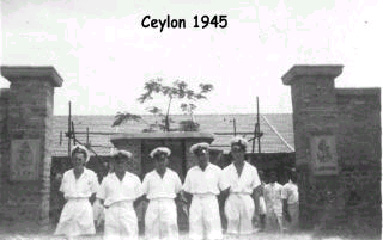
Renown was to be my last ship. I was posted ashore to the pool of men ready to go to any of the ships in the Far East Fleet to replace sick or injured men. It was on 26 Oct 1943 that I joined H.M.S. LANKA, which was the Royal Naval Barracks in Colombo, taken over from St. Josephs College.
I was given a job in the Wet Canteen as second in charge. The Naval side was discipline of the Ratings of any Naval Ship calling at Colombo. We had quite a few cases of drunkenness. If it was early evening the offender was put in the cooler and, if able, was sent on their way. Usually, this worked. If not, the Naval Patrol was called and they dealt with it. There were times when the Escort was called for, as the Patrol had the facilities to deal with some events.
As with any Wet Canteen anywhere in Naval Port, trouble will occur through drink in Wartime.
I was made Chief Petty Officer whilst there and was in charge for a while I was relieved on the 31 March 1944, as the job did not call for two Chief Petty Officers and by then another Chief, senior to me, had joined. As usual promotion means shifting jobs so went to a pool waiting posting on 31 March 1945.
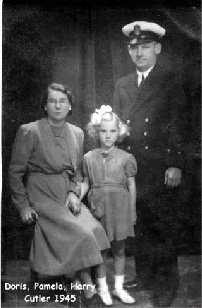 H.M.S. Chinkara Naval Barracks in Cochin Southern India.
H.M.S. Chinkara Naval Barracks in Cochin Southern India.
Dates: 13 April 1945 to 8 July 1945
This was a transport base of ratings awaiting drafting. I was in charge of the organization of all the Ratings and was there until 9 July 1945 when we left for England via Bombay. We had a week in a camp waiting and I was able to see a little of Bombay.
We left Bombay on the Liner/Transport ship "Edinburgh Castle" and arrived at Greenock on VJ Day (Victory over Japan Day). We had had no news of that until we were on the train to Devonport. The ship broadcast had been shut down. The train came alongside and we boarded it at 11pm and that’s when we heard the news. We arrived Naval Barracks Devonport next morning and went on leave next day for 5 weeks.
When I returned to Barracks one was given a civilian suit of your own colour and fit, which was quite a job. It was 10 July 1945 as on that went in barracks as a naval man and came out a civilian after 24 years 8 months of service. Was paid until 10 November 1945. Until then I could be recalled if required. Even until the age of 55 I could be recalled in the event of hostilities.
Notes: The dates joining a ship and leaving are correct as all are recorded on my service papers also conduct and promotions.
Between the times of leaving one and joining the next was spent in the Gunnery School on courses or learning of any new advances in Gunnery. At times was on working parties in the RN Barracks to which the Gunnery School was attached.
Not of choice, but after H.M.S. HOOD, it was Destroyers or below till 1935 when joined DORSETSHIRE. After in 1937 was Destroyers till 1943. Although I enjoyed serving in them, the rough weather was not good. I did not suffer seasickness though.
The end of the War was also the end of my career in the Navy of 24 years, 8 months, 23 days.
Additional Photos |
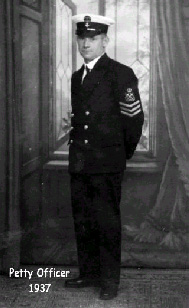 Harry as a Petty Officer in 1908. |
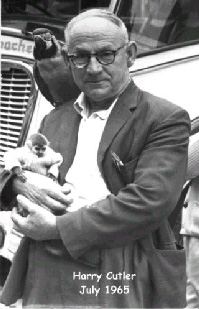 Harry in 1965. |
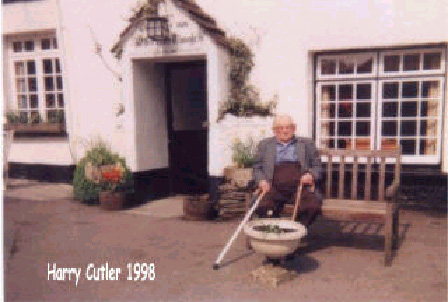 Harry in 1998. |
No known memorials
Sources
Commonwealth War Graves Commission
'Register of Deaths of Naval Ratings' (data extracted by Director of Naval Personnel (Disclosure Cell), Navy Command HQ, 2009)
The Empire Cruise by VC Scott O'Connor
